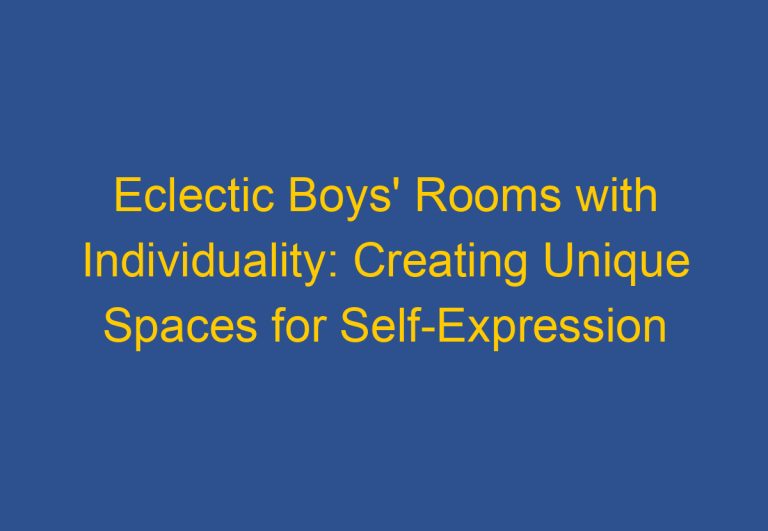21 Shared Closets for Kids Ideas: Maximize Space and Style for Growing Families
Shared closets can be a challenge for parents, especially when it comes to keeping everything organized. Using effective storage solutions can help kids share a closet comfortably and teach them valuable life skills.

From using double rods to cube storage systems, there are many ways to optimize space and make it easier for children to reach their belongings.
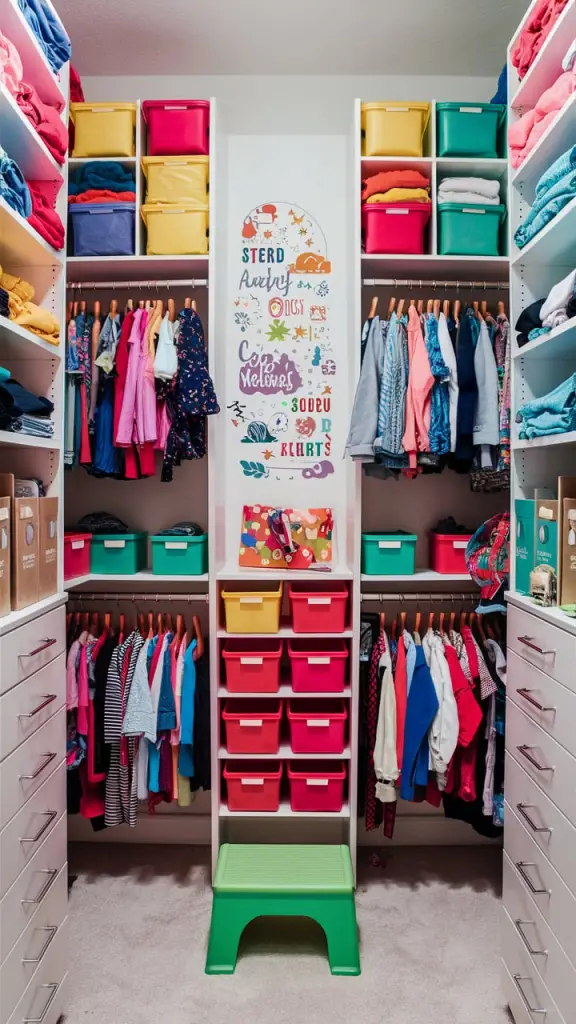
One useful strategy is to divide the closet space evenly, giving each child their designated area. This can be achieved with a closet system from brands like The Container Store, which offers various components to suit every need.

Baskets or tubs can also be great for storing items like toys, clothes, and games, keeping everything tidy and accessible.
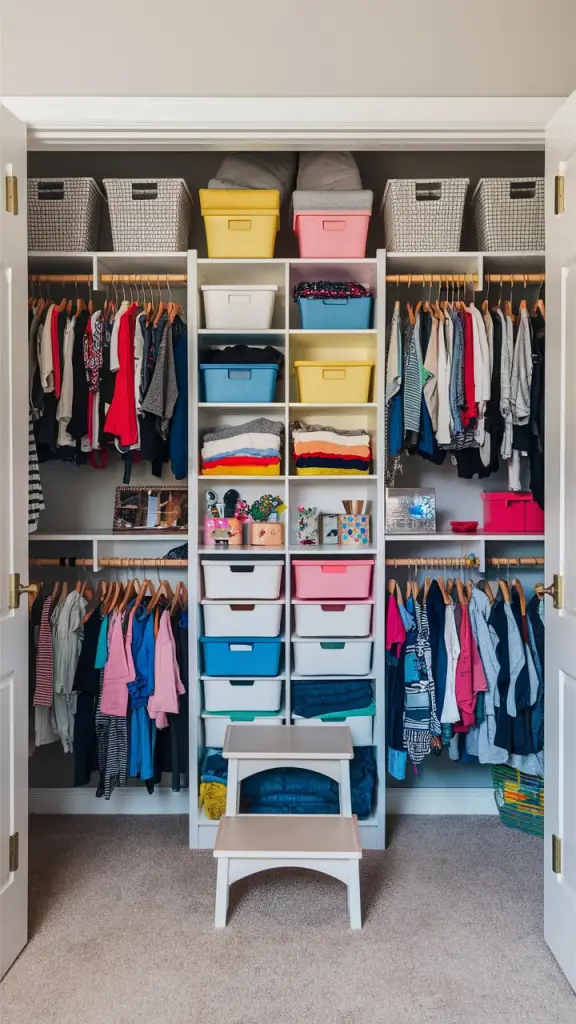
In this article, readers will find 21 creative ideas for organizing shared kids’ closets. Solutions range from functional and straightforward to fun and engaging, ensuring that children not only keep their space neat but also enjoy the process.
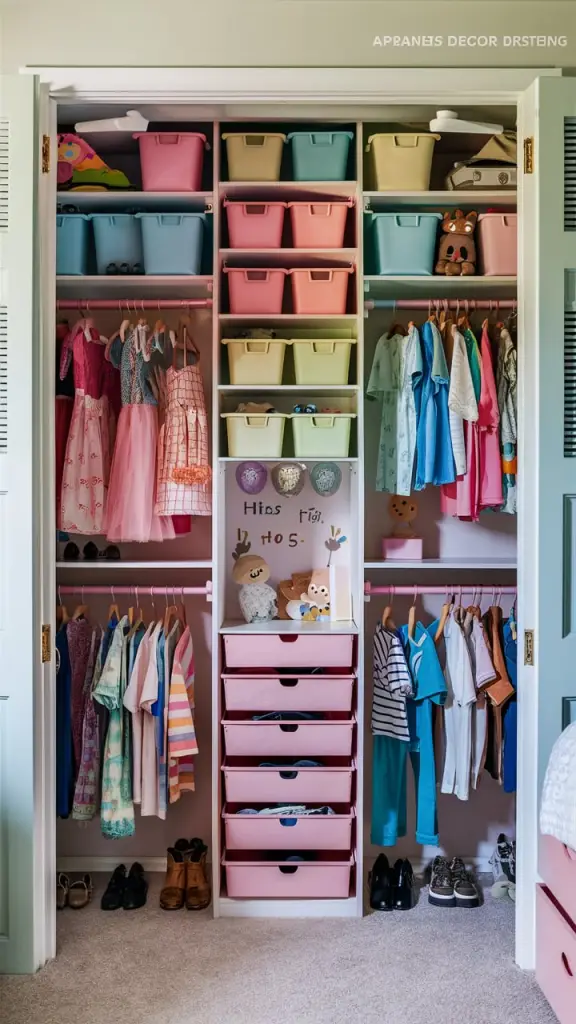
How To Organize Your Kids Closet So That Two Kids Can Share One Closet

Organizing a shared kids’ closet can be a fun project. A good plan makes it easier for kids to find their things and keep the space tidy.

Start with a Closet System
Using a closet system can create separate areas for each child. Place the system in the middle to divide the closet equally. This gives each child their own space.

Use Hanging Bars
Install a low hanging bar for easy access. This allows children to reach their clothes without help. It also teaches them how to put clothes away.
Add Shelving
Place shelves above the hanging bars. This is perfect for hats, bags, and other items.
Incorporate Drawers
Using drawers is a smart way to organize smaller items. Each child can have their own drawer for socks, underwear, or pajamas. They can also have a shared “junk drawer” for special treasures.

Keep It Balanced
Make sure each child has equal access to space. This can prevent fights over who gets what part of the closet.
Use Clear Bins
Clear bins or baskets are great for storing toys or seasonal clothes. Label each bin with the child’s name or contents for easy identification.
By following these tips, a shared kids’ closet can stay organized and functional. Each child will enjoy their space and learn how to keep it tidy.
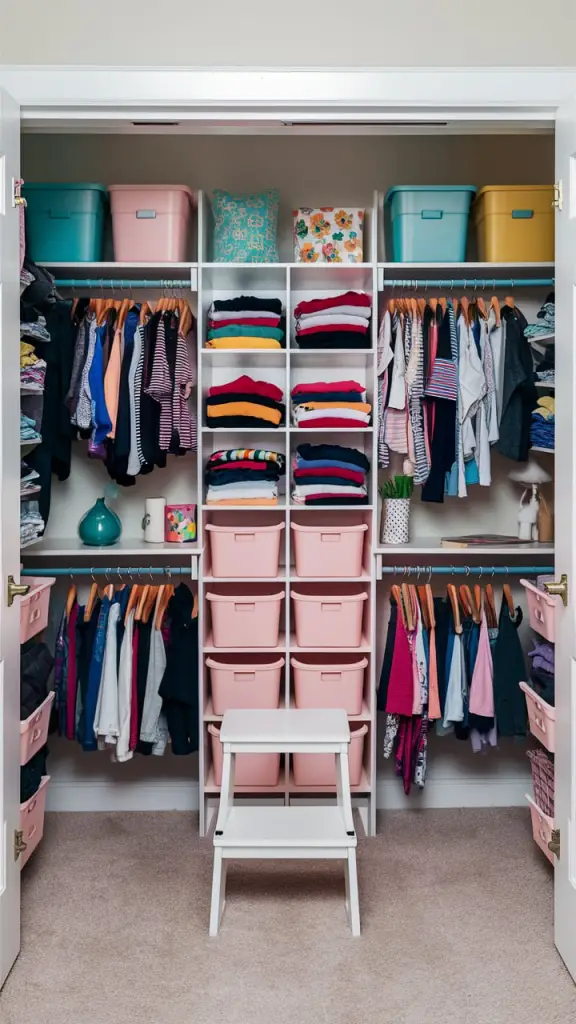
Installing A Shelving System Can Eliminate The Need For Dressers

A well-designed shelving system offers a smart alternative to traditional dressers. By using open shelves and modular organization systems, it maximizes space and improves accessibility for kids.
Benefits of a Shelving System:
- Open Shelving: Open shelves allow kids to see their clothes easily. This encourages them to keep their space tidy.
- Cubbies and Small Drawers: Adding cubbies or small drawers can store accessories, like socks and underwear, without needing a dresser.
- Floating Shelves: Incorporating floating shelves adds vertical storage, freeing up floor space for play.
Types of Shelving Solutions:
- Wire Shelves: Good for ventilation, they can hold baskets for toys or clothes.
- Shallow Drawers: Ideal for organizing smaller items, shallow drawers fit perfectly into shelving systems.
- Built-In Drawers: Built-in options allow you to customize storage based on the closet’s size.
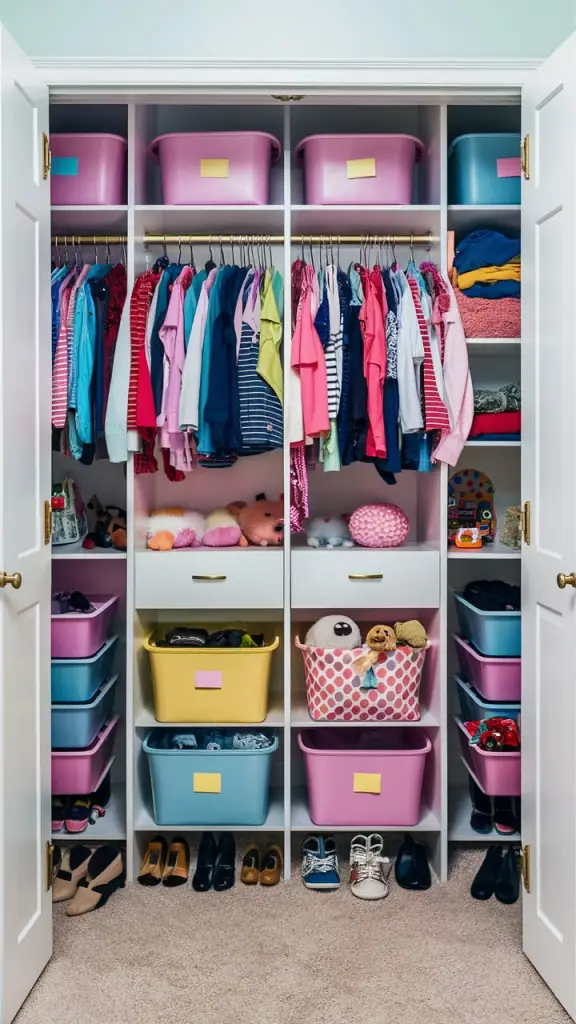
Installing a shelving system requires careful planning. Consider the height and reach of the child. Lower shelves ensure they can access their clothes without help.
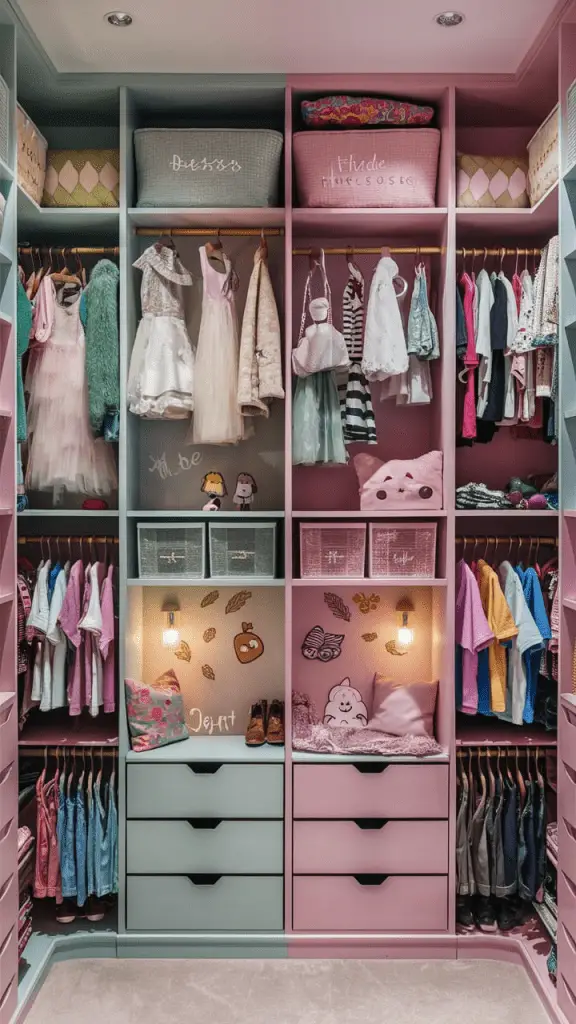
In summary, a shelving system can streamline the organization of shared kids’ closets. By using shelves instead of dressers, families can create functional and space-saving solutions that grow with the children.
Kids Shared Closet Organization Issues

Organizing a shared closet for kids can come with its own set of challenges. Different preferences and styles can lead to disputes over space and organization.
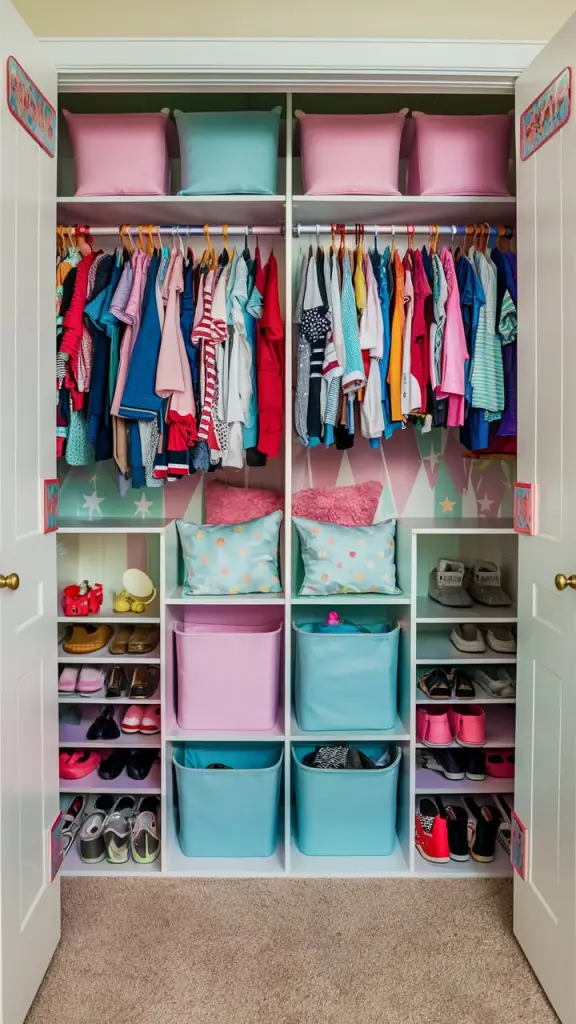
Clutter Accumulation
Kids often accumulate clothes that don’t fit anymore. Regularly decluttering is essential. Set aside time to go through clothes like dresses, pants, and dress shirts.
Decision-Making
When it comes to purging, kids may struggle to decide what to keep or donate. Creating a separate donation bin can help them visualize what can go.
Space Division
Fairly dividing space can be tricky. Each child should have designated areas for their items. Using dividers or shelves can promote equal access.
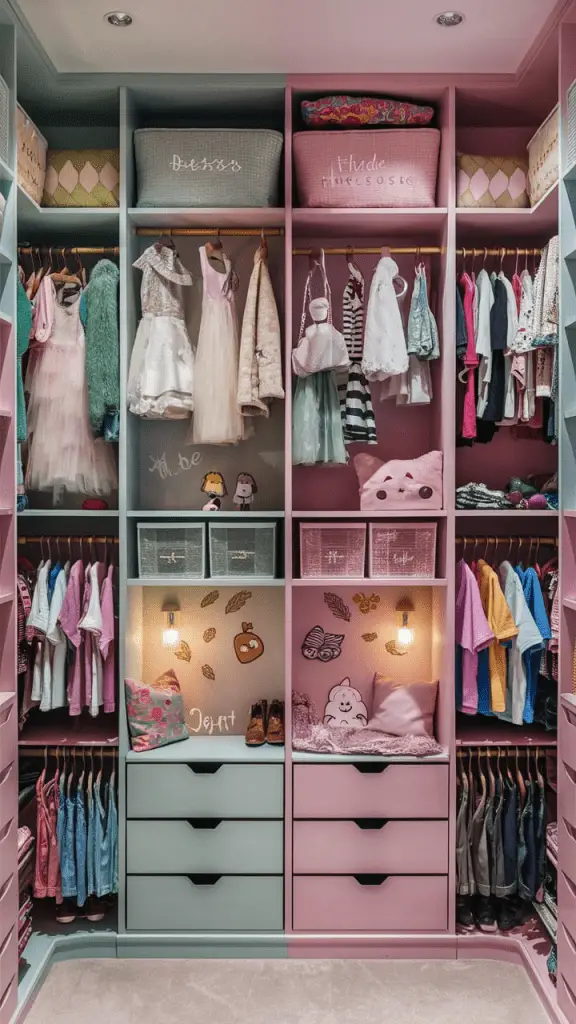
Accessibility Issues
If storage is too high or complex, kids may not use it. Ensuring that all items are within reach allows children to take responsibility for putting things away.
Teamwork
Encouraging teamwork in organizing can be beneficial. Kids can work together to sort and arrange items, making the task less daunting and more enjoyable.
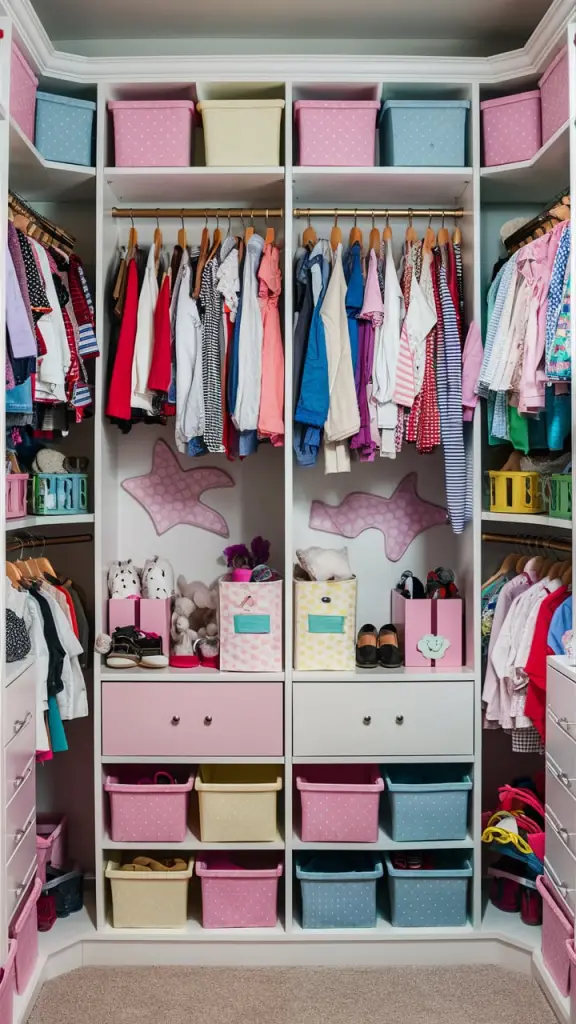
Style Differences
Differences in style can create tension. Clear communication about likes and dislikes helps minimize conflicts and fosters respect for each other’s choices.
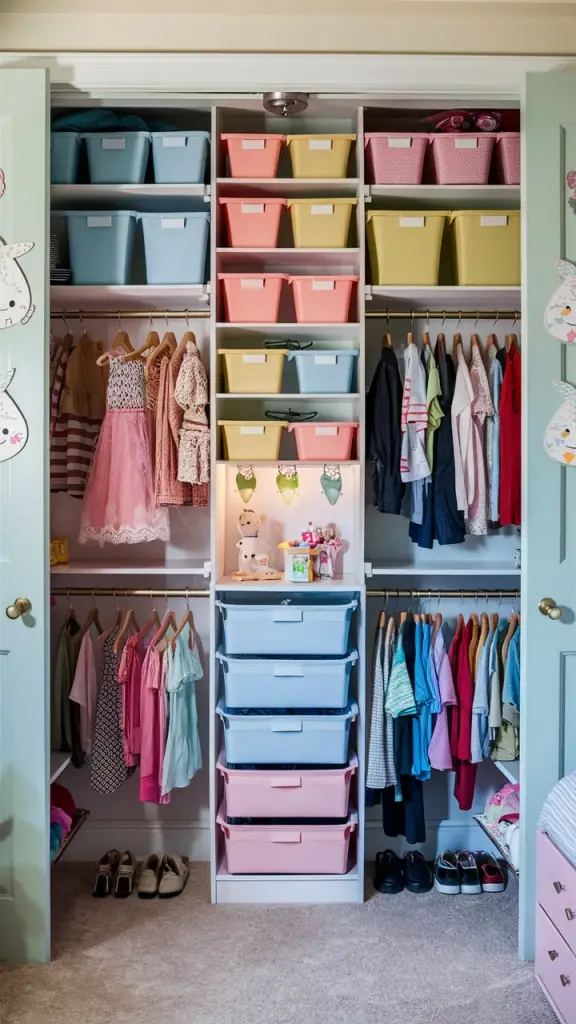
These issues can be managed with patience and organization, creating a functioning and harmonious shared closet space for kids.
Kids Shared Closet Organization: Tweaking The Closet To Solve The Problems

Managing a shared closet for kids requires a practical approach. Here are some effective tweaks to make the space work better:
Hanging Systems: Adding a dual hanging rod system can create more hanging space. This allows clothes to be arranged by type or size.
Concealed Spaces: Using baskets or bins under hanging rods helps conceal items like shoes or toys. This keeps the closet looking tidy.
Adjustable Hanging Rods: Investing in adjustable rods is wise. They grow with the kids, allowing for different clothing lengths over time.
Drawer Division: If there are drawers in the closet, using dividers can keep smaller items organized. This is especially useful for accessories.
Color Coding: Assigning colors for different clothing types helps kids find items easily. This method makes getting dressed quicker.
Labels: Labeling shelves or bins can guide children in returning items to their rightful place. Clear communication aids in maintaining order.
Floor-Level Storage: Incorporating cube storage at floor level is helpful. Kids can access toys and clothes easily without adult assistance.
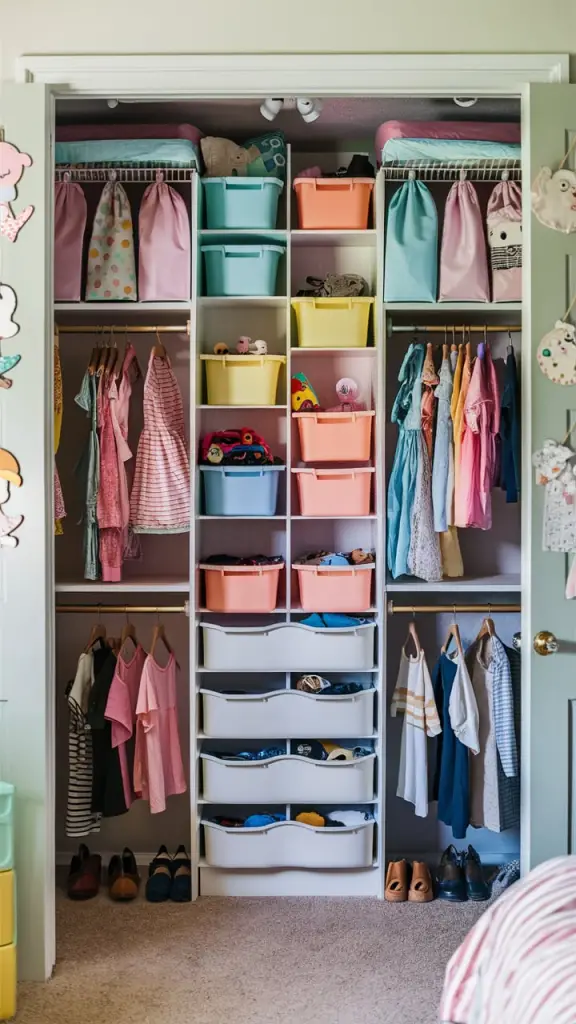
By applying these ideas, a shared kids’ closet can be functional and user-friendly. Small changes make a big difference in keeping the space organized and more enjoyable for the kids.
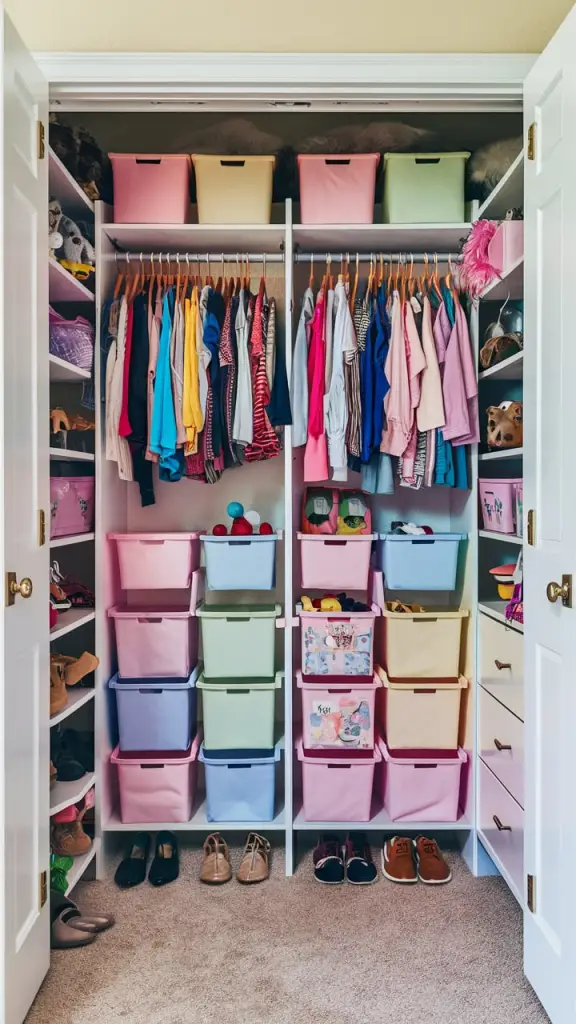
How To Organize A Shared Kids Closet

Organizing a shared kids closet can be both fun and practical. Start by ensuring each child has equal space. A wire closet organizer can provide shelves and hanging areas for clothes.
Steps to Organize:
Divide the Space:
- Use a closet system to create sides for each child. This separation helps kids understand which section is theirs.
Use Baskets and Bins:
- Baskets are great for toys and seasonal clothes. Label each basket for easy identification.
Incorporate Double Rods:
- Adding double rods increases hanging space. Kids can reach their clothes, promoting self-sufficiency.
Cube Storage:
- Cube units can hold shoes, games, and books. Place these at a height accessible for children.
Keep it Fun:
- Get kids involved in organizing. Use bright colors or fun designs to make it exciting.
This approach makes a shared closet tidy and encourages responsibility. Setting clear organization ideas helps everyone know where things belong.
Storage Tips For Kids’ Closets

Effective storage makes kids’ closets neat and functional. Here are some helpful tips:
Use Baskets and Bins: Incorporate baskets and storage bins for toys, clothes, and accessories. Color-coordinated containers can also make organizing visually appealing.
Shallow Drawers: Small drawers work well for clothing items. They allow kids to see their options without digging through piles.
Oversized Baskets: For larger items like blankets and stuffed animals, oversized baskets provide ample space. They keep things tidy and accessible.
Wire Baskets: These can be used on shelves for easy access to books and toys. They allow kids to spot items quickly.
Laundry Storage: Having a designated area for laundry can help manage clothes. Consider collapsible hampers for easy use.
Shoe Storage: Use bins or racks for shoe storage. This keeps shoes together and organized, making it easier for kids to find what they need.
Toy Cabinets and Cubbies: A toy cabinet or cubby system can help kids manage their toys. It encourages them to return items after playing.
Accessories Organizer: Adding a small unit for bows and headbands can keep accessories organized. This prevents tangled messes.
Implementing these tips helps maximize storage space in kids’ closets while teaching them important organizational skills.
Divide The Closet Evenly – Closet System

Creating a shared kids’ closet requires carefully dividing the space. A closet system can make this task easier.
Start by using dividers to split the closet. This helps each child know what space is theirs. Clear labels can also help in maintaining order.
Consider a symmetrical layout. This means each side looks balanced. For example, if one child has a section for clothes, the other should have an equal space for their items as well.
Double rods can maximize vertical space. Use one rod for shorter clothes and another above it for longer items. This system allows for efficient use of the closet height.
To further organize, include shelves or baskets. Each child can have their own designated area for toys, shoes, or seasonal items. This makes it easy to keep the closet neat.
Make sure that each child has equal access to shared items. This prevents conflicts and promotes cooperation. Regularly check the closet to ensure that it stays organized.
Incorporating these elements into a shared closet can create a functional and organized space for kids. It keeps everything accessible and teaches children about sharing and responsibility.
Add A Step Stool

A step stool is a practical addition to any shared kids’ closet. It allows children to reach higher shelves and storage areas without struggle. This can make getting dressed easier and more fun.
Benefits of a Step Stool:
- Accessibility: Kids can easily grab clothes or toys stored up high.
- Independence: Children can learn to reach for their items without always needing help.
- Safety: Many step stools come with anti-slip surfaces. This reduces the risk of slipping.
When choosing a step stool, look for these features:
- Sturdy Material: A strong build ensures it can handle weight.
- Lightweight: A stool that is easy to move around helps kids use it comfortably.
- Height: Select a height suitable for the shelves in the closet.
To encourage its use:
- Place the step stool near the closet entrance.
- Make it a part of the daily routine for accessing clothes and toys.
Using a step stool can transform how children interact with their shared closet. It encourages them to take responsibility for their belongings while promoting confidence in their ability to reach what they need.
Add Fun Inspiration For Growing And Moldable Minds

Creating a shared kids’ closet can be both practical and fun. With a little creativity, it can become a place that sparks joy and imagination.
Playful Wallpaper: Adding fun wallpaper can transform a closet space. Choose bright colors or whimsical patterns that reflect each child’s personality. This simple change can make the closet a more inviting area.
Kid-Friendly Storage: Using small, accessible bins and cubbies helps kids feel involved. When children can reach their own items, they are more likely to keep things tidy. Consider using bins with labels to make it easier for them to find and put away their clothes and toys.
Custom Touches: Personalizing a closet is a great way to inspire creativity. Parents can encourage kids to add their own artwork or decorate with stickers. This involvement helps children take ownership of their space.
Incorporate a Window Seat: If space allows, adding a small window seat can create a cozy nook. Kids can use it for reading or playing, adding more functionality to the closet. It’s a perfect spot for them to relax or engage in imaginative play.
By mixing style and practicality, a shared kids’ closet can be a place where they enjoy spending time. With thoughtful design, it can inspire their growth and creativity.
Kids Closet Organizer | How We Organize A Shared Closet

Organizing a shared kids’ closet can be fun and efficient. It helps everyone find their clothes easily and keeps the space tidy.
Use Closet Organizers:
These tools help maximize space. Consider items like shelves, baskets, and hanging organizers. They allow for separation of clothes and accessories.
Label Everything:
Labels are key. They help kids know where things belong. Simple labels like “shirts,” “pants,” and “toys” make it easy for them to keep their space organized.
Drawer Dividers:
These are perfect for separating smaller items. Use them for socks, underwear, or art supplies. Drawer dividers keep things in order and easy to find.
Slimline Hangers:
Thin hangers save space. They provide a neat way to hang clothes without taking up too much room. Slimline hangers also help keep clothes from slipping off.
Daily Clothes Organizers:
A daily organizer can help kids pick outfits for the week. Having a labeled section for each day keeps morning routines smooth.
Rotate Seasonal Items:
Store out-of-season clothes in bins. This frees up space for current clothing. It helps kids see what they have and makes getting dressed simpler.
These methods create a shared closet that is functional and enjoyable for kids.
How Do You Organize A Small Shared Kids Closet

Organizing a small shared kids closet can be a fun project. First, assess the space. Determine what each child needs and how to divide the closet.
Divide Space Evenly
Each child should have their own area. They can share the hanging space or have separate sections for their clothes.
Use Storage Solutions
Baskets and bins are helpful. This keeps toys and clothes organized. Clearly label each basket to help kids know where things go.
Incorporate Shelving
Install shelves at kid height. This makes it easy for them to put away and grab their items.
Double Up on Hanging Space
Use a closet doubler rod. This adds extra hanging space without needing a larger closet. It allows kids to access their clothes easily.
Include Cube Storage
Cubes can hold small items like shoes, games, or blankets. Placing these at floor level helps young children reach them.
Keep it Accessible
Ensure all items are easy to see and reach. This encourages kids to keep their space tidy and organized.
By planning smartly and using the right tools, a small shared closet can be functional and efficient.
How Do You Organize Shared Children’s Closet

Organizing a shared children’s closet can be fun and practical. Here are some effective tips to make it work.
Divide the Space: Start by splitting the closet evenly between the children. This gives each child their own area for clothes and belongings.
Use Closet Organizers: Investing in a good closet organizer can help maximize space. Use shelves, bins, and rods to keep the closet neat.
Color-Code Items: Use colors to organize different types of clothing. For example, assign a specific color for each child’s clothes. This makes it easier for kids to find what they need.
Baskets and Tubs: Use baskets or tubs to store toys, shoes, or outgrown clothes. They are easy to label and keep things tidy.
Lower Storage: Place cube storage or lower shelves at kids’ eye level. This allows them to access their items easily and encourages them to keep things organized.
Double Up on Rods: Install double rods to create more hanging space. This helps younger children reach their clothes without needing assistance.
By using these tips, organizing a shared closet can make daily routines smoother and teach children valuable skills in maintaining their space.
How Do You Separate Kids In A Shared Bedroom

Separating kids in a shared bedroom can create personal space and reduce conflicts. Here are some effective ideas:
Use Room Dividers: A room divider, like a tri-panel screen, creates a visual boundary. It can be easily stored when not in use.
Curtains or Canopies: Hang curtains around each bed to create a cozy area. This gives each child a sense of privacy while sleeping.
Furniture Arrangement: Place beds on opposite walls. This setup can help each child feel more space and less cramped.
Storage Solutions: Use headboards with built-in storage. This keeps personal items organized and helps free up floor space.
Designate Zones: Assign specific areas for each child’s toys and clothes. Color coding zones or using labels makes it easier for each child to keep track of their belongings.
Shared Decor Styles: Pick a theme that all kids like but allow them to choose their own bedding or wall art. This way, they feel ownership over their part of the room.
Personal Touches: Encourage each child to decorate their space with personal items. This can include photos or favorite books.
These strategies help maintain harmony and structure in a shared kids’ room. Following these tips can lead to a more organized and enjoyable living space for everyone involved.

